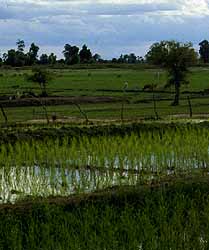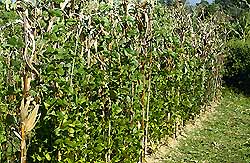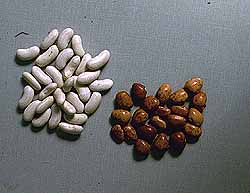Traditional Agriculture
 |
|
|
- Overview
- Ladakh; A Case Study of Traditional Agriculture
- Key Facts and Figures
- Important Terms
- Commentary: Future of Traditional Agriculture
- Useful Links
- Useful Literature
- Cited Literature
Prepared by
Luc Kazimirski
for Biology 4806
Special Topics, Fall 1998.
OVERVIEW
INTRODUCTION
Around the world, there is growing interest in finding alternatives to the industrial farming methods that have emerged during the 20th century. The deleterious effects of pesticides, inefficient fossil fuel usage, chemical fertilizer inputs, genetic monocultures and factory farming of livestock have become increasingly apparent (Matson et al., 1997). One approach is to build upon traditional methods which evolved over the first 10,000 years of agriculture. These produced a tremendous variety of domesticated crops and livestock, and systems of farming. While some systems proved environmentally destructive, many were not and were able to sustain diverse cultures for centuries. Unfortunately, within the last generation, much of the know-how of traditional systems have been lost, especially in the more industrialized countries.Fortunately, there is still a vast store of farming know-how in many of the less developed countries. Researchers are beginning to appreciate that many traditional farmers in the developing world are still practicing farming methods that are in balance with the surrounding ecosystems, stable, sustainable and highly efficient. Farmers, who have sometimes been portrayed as ignorant and not adaptive, have actually been utilizing very sophisticated methods of agricultural production for centuries. These farming systems can perhaps help the developed world to grow food with fewer chemical inputs, slow erosion, control pests, decrease our dependence on fossil fuels and feed an expanding global population.
This page provides an overview of traditional farming, and cites literature and links for further infomrtation. The main types of traditional systems are discussed along with their common features. Traditional systems are examined for their role in the preservation of biological diversity and the future of traditional agriculture is explored. There is also a case study of the farming methods employed in LADAKH, India. This information is based on a recent trip to the area by the author.
TYPES OF TRADITIONAL AGRICULTURE
Based on the work of Deshmukh (1986), traditional agricultural systems can be classified into one or more of the following basic categories.
COMMON CHARACTERISTICS OF TRADITIONAL SYSTEMS
Based on a literature survey with particular reference to Altieri (1987) and Marten (1986), I suggest that the following characteristics can be considered common, and important features of traditional farming systems.
- Focus on risk reduction
- Year round vegetative cover of soils
- System diversity: farm systems based on several cropping systems, cropping systems based on a mixture of crops, and crops with varietal and other genetic variability.
- Trophic complexity approaching natural systems. Multiple interactions between plants, weeds, pathogens and insects
- High net energy yields because energy inputs are relatively low.
- Low levels of inputs and high degree of self-sufficiency

Intercropping of maize and beans
PERSERVATION OF BIOLOGICAL DIVERSITY
 |
|
|
Modern intensive agroecosystems that rely on monocultures and genetic homogeneity have become more susceptible to disease and pests, and to climatic variation ( link to agroecosystems home page). The varieties used, like HYV, tend to be high yielding only when supplied with intensive inputs and ideal growing conditions. Traditional varieties are of value to us because they embody characteristics that are potentially valuable, but not yet exploited. In the future, new varieties will be needed that can survive in adverse environmental conditions such as saline or acidic soils. The genetic resources needed to develop these new strains will probably come from the diversity of plants stored in traditional agroecosystems.
Traditional farming systems also promote genetic diversity. The landscape in a traditionally farmed area is a patchwork of different vegetation types created by the farming methods. The result is a variety of ecological niches that encouraged biological diversity. The landscape, even in intensively managed areas, is a mosaics of cultivated, grazed, uncultivated, and successional areas. Evidence from tropical forests as well as desert areas in the Americas shows that certain traditional agricultural activities increased the number of species present rather than decreased them (*FAO, 1996). Some of the areas with the richest species diversity, such as tropical forests, have been managed by humans for centuries. It is revealing to compare this diversity to the homogeneity apparent in modern farming; massive areas planted exclusively with a single strain of crops.
It is because of the diversity embodied in traditional farming
systems, that in situ conservation of traditional varieties is
promoted (*FAO, 1996). On-farm conservation leads to productive
genetic diversification; the development of diversity that is
useful and appropriate for traditional farmers and adapted to
local growing conditions. In situ conservation also ensures that
control remains in the hands of the farmers who will be managing
the crops and is a constant stimulus to more productive agriculture.
Ex situ conservation is also important but the Fourth International
Technical Conference on Plant Genetic Resources held in June 1996
in Leipzig, Germany, decided ex situ conservation is "predominantly
for the purpose of complementing in-situ measures" (*FAO, 1996).
TRADITIONAL AGRICULTURE IN LADAKH, INDIA
Ladakh has a relatively undistured traditional culture which utilizes
unique methods of agricultural production. The system is sustainable,
stable and shares many of the common characteristics of traditional
systems described in this page. Studied carefully, traditional
agriculture often exhibits unique adaptive methodologies (Marten,
1986). In the case of Ladakh, an unusual system of fertilizing
soils and an intricate irrigation network. Combined, these techniques
allow Ladakhi people to flourish in an otherwise harsh and inhospitable
climate.
KEY FACTS AND FIGURES
Traditional systems are still important
- It is estimated that 20% of current world food production is still
produced from traditional multi-cropping systems (FAO, 1996).
- Small farmers provide as much as 70% of the food production in
many tropical countries. (Govinden, 1984)
- Small farmers own 50% of the land in India (Nellithanam and Samiti
1998)
- In India, 60% of the population is employed in agriculture (Green, 1987).
Traditional systems are efficient
- Swidden farming can yield food energy up to 20 times the human energy invested (Russell 1988)
- Intensive systems in the United States can yield as low as one
tenth as much food energy as is invested in energy inputs. (Russell
1988).
- Pest losses in traditional agriculture range from 10 to 40 %.
This is similar to modern agriculture which relies on pesticides
(Brown and Marten, 1988)
Traditional farms are usually small
- The average farm size in Southeast Asia is 1.8 ha.
80% of the farmers depend solely on their own labor (Marten, 1986)
- In India, 2 ha is the national average farm size (Green, 1987).
- In 1978, the average farm size in Iowa was 108 ha. (Loomis, 1984)
Traditional systems created and conserve species and gene pool diversity
- 319 species of plants in a virgin tropical forest, 223 species after cutting, planting and 10 years fallow (Pye-Smith, 1997).
- Of the 3,831 breeds of cattle, water buffalo, goats, pigs, sheep,
horses, and donkeys that have existed this century, 16% have disappeared,
and a further 15% are rare. (*FAO, 1996)
- It is estimated that high-yield varieties (HYVs) are now used
on 52% of the world║s wheat growing areas, 54% of land planted
with rice, and 51% of maize farms. (*FAO, 1996)
- Of the approximately 7,000 species of plants that have been cultivated
or collected by humans for food, only 30 crops now account for
95% of the global dietary energy (calories) or protein. Wheat,
rice and maize provide more than 50% of the global plant-based
energy intake. Nearly 90% of the food energy supplies of the world
is provided by only 103 plant species. (*FAO, 1996)
- In India the mango, Mangifera indica, has been bred to create
1,000 varieties, and some 100,000 varieties exist of one species
of rice, Oryza sativa. (*FAO, 1996)
- There were 300-400 varieties of rice traditionally grown in Sri
Lanka, in 1982 only 15-20 were left. (Goldsmith, 1982)
- India had over 40 thousand varieties of rice, as of 1987, only 30 were commonly grown. (Green, 1987)
IMPORTANT TERMS
(adapted from Marten and Saltman, 1986.)
- TRADITIONAL AGRICULTURE
- Sustainable, stable farming system that has been used for several
generations and has been able to supply the nutritional and material
needs of its producers.
- STABILITY
- The reliability or consistency of yields. This factor reflects
an agro-ecosystem║s ability to be productive despite diverse perturbations.
A stable system will maintain acceptable yields even in years
that are climatically harsh or have pest problems. Traditional
farmers place a high priority on stability as well as risk reduction
and social concerns.
- SUSTAINIBILITY
- The ability of a system to maintain productivity and stability
year after year. This is effected by the ecological processes
at work in the agro-ecosystem and reflects the system║s ability
to maintain favorable growing conditions through time. Loss of
sustainability is generally associated with undesirable changes
to the soil such as a decrease in soil fertility, persistent erosion
or invasion of pests. Most traditional farming systems are highly
sustainable; they have been practiced for thousands of years without
changing the ecology of the soils.
- PRODUCTIVITY
- The yield of goods and services from an agro-ecosystem. This is
generally measured in mass of goods produced per unit area but
can be more broadly defined to include sustainability, stability,
nutritional value, esthetic qualities and other community functions.
- CULTURAL ENERGY
- The total energy inputs into the farming system exclusive of solar energy. This broad term encompasses inputs such as caloric intake of farm workers, the energy value of petrochemicals used to manufacture fertilizers and the fossil fuel used in tractors. Often considered to be synonymous with the term energy subsidy.
COMMENTARY: THE FUTURE OF TRADITIONAL AGRICULTURE
Traditional farming is being replaced by modern intensive farming systems. This represents the loss of farming systems that are stable, sustainable and from which many valuable lessons can be learned. Traditional farming is also an important reserve and source of biodiversity. It is still perhaps the only sustainable system on marginal land. High yields of modern intensive agriculture have made it possible for the ever-increasing human population to be fed without the extensive destruction of habitats to provide the needed food. Unfortunately, this has been accomplished at the expense of the surrounding ecosystems. The challenge for the future is how to increase yields in traditional systems while retaining a certain measure of their integrity, in other words, to finds methods of sustainable intensification. Conversely, we need to integrate biological diversity into existing modern commercial agricultural systems
There is evidence that the adoption of conservation methods on large commercial farms can promote biological diversity (*FAO, 1996). Techniques such as crop rotation, intercropping, cover crops, integrated pest management, and green manures can be used in larger commercial systems. These practices can reduce dependence on fertilizers and pesticides and promote sustainable intensification. An integration of farming systems, combining the productivity of modern systems and the sustainability of traditional systems, could help to preserve biological diversity and feed a growing population without excessive damage to the environment.
USEFUL LINKS
ETHNOPEDOLOGY
& SOIL; ECOLOGY
(http://www.nrel.colostate.edu:8080/~bobn/rkn.3b.SOIL.TEK.html)
Bob Niles, Auth. (1999, November 18; Viewed 5 Feb. 2001) Excellent
bibliography of works on traditional soil knowledge.
NUFFIC:
CIRAN INDIGENOUS KNOWLEDGE
(http://www.nuffic.nl/ik-pages/index.html
) Netherlands Oorganisation for International Cooperation in Higher
Education, and Centre for International Research and Networks, Spons.
(1999, January 11; Viewed 5 Feb. 2001)
Nuffic-CIRAN aims to
facilitate and improve the exchange
of information within the
International Indigenous Knowledge (IK) Network.
They publish online
the Indigenous
Knowledge and Development Monitor
PESTICIDE ACTION
NETWORK (PAN) ASIA AND THE PACIFIC
(http://www.poptel.org.uk/panap/) Pesticide Action
Network (PAN) Asia and the Pacific, Spons. (1998, December 1; Viewed 5
Feb. 2001)
Good information on the ongoing work to preserve
traditional agriculture.
Try the link to the sustainable agriculture
page.
TRADITIONAL
PRACTICES FOR PLANT DISEASE MANAGEMENT
IN TRADITIONAL FARMING SYSTEMS
(http://www.tropag-fieldtrip.cornell.edu/tradag/default.html)
H. David
Thurston, Auth. (1998, October 13; Viewed 5 Feb.
2001)
Site maintained by David Thurton, Professor
Emeritus, Cornell University.
Complements his book (listed under
Useful Literature)
UNEP/CBD/SBSTT
CONVENTION ON GENERAL BIOLOGICAL DIVERSITY :
AGRICULTURAL
BIODIVERSITY
(http://www.iisd.ca/linkages/biodiv/sbstta/sb210.html) United
Nations Environment Program, Spoons. (1998, August 16; Viewed 5 Feb. 2001)
Important information on history of genetic diversity in
agriculture,
examples, principles for conservation
USEFUL LITERATURE
- Altieri, M. A. 1987. Agroecology: The Scientific Basis of Alternative Agriculture.
Westview Press, Boulder.
"Dr. Altieri combines traditional farming knowledge and modern
agroecological principles for designing systems with effective
soil conservation features, nutrient restoring capabilities, and
built in biological pest-control mechanisms" (from the cover)
- Marten, G. (ed) 1986. Traditional Agriculture in Southeast Asia A Human Ecology Perspective. Westview Press, Boulder, Colorado.
In this book, agronomists, ecologists and sociologists use a human
ecology perspective to describe how traditional agriculture functions.
- Oldfield, M.L. and J.B. Alcorn. 1991. Biodiversity: Culture, Conservation and Ecodevelopment. Westview Press, Boulder,Colorado.
"The contributors assess traditional management of plant and animal
diversity, explore the rationale for in situ conservation, and
discuss existing and possible linkages between development and
conservation." (from the cover)
- Reij, C., I. Scoones, and C. Toulmin. 1996. Sustaining the Soil. Indigenous Soil and Water Conservation in
Africa. Earthscan Publications Ltd., London.
This book shows how indigenous techniques are being used successfully
in Africa to conserve and harvest soil and water, and advocates
a fusion of traditional and modern approaches to soil and water
conservation.
- Richards, P. 1985. Indigenous Agriculture Revolution: Ecology and Food production in West Africa.Westview Press, Boulder, Colorado. Richards makes the case that "many environmental problems are, in fact localized and specific, and require local, ecologically particular responses. the issue then becomes how to stimulate such situation-specific responses. One of the answers explored below is through mobilizing and building upon existing local skills and initiatives...to stimulate vigorous :indigenous science' and indigenous technology."
- Thurston, D. 1992. Sustainable Practices for Plant Disease Management in Traditional Farming Systems. Westview Press, Boulder, Colorado. Thurston incorporates a wide range of literature to describe how systems and specific methods in employed traditional agriccultural systems function in the control of plant disease.
CITED LITERATURE
- Altieri, M. A. 1987. Agroecology, The Scientific Basis of Alternative Agriculture. Westview Press, Boulder, Colorado.
- Cherfas, J. Farming goes back to its roots. New Scientist , 9 May 1992: 12-13.
- Deshmukh, I. 1986. Ecology and Tropical Biology.. Blackwell Scientific Publications, Oxford.
- Eckholm, E. 1980. The value of small farms. Focus 30 (3): 11-16
- Goldsmith, E. 1982. Traditional agriculture in Sri Lanka. The Ecologist 12: 209-216.
- Govinden, N. 1984. Intercropping in the tropics: advantages and relevance to the small farmer. Canadian Journal of Development Studies 5: 213-232.
- Green, T. 1987 Organic farming in India. Alternatives 15(1): 4-13.
- Innis, D. 1980. The future of traditional agriculture. Focus 30 (3): 1-8.
- Loomis, R. 1984. Traditional agriculture in America. Annual review of Ecology and Systematics 15: 449-478.
- Marten, G. 1986. Traditional agriculture and agricultural research in Southeast Asia. In G.G. Marten (ed), Traditional Agriculture in Southeast Asia A Human Ecology Perspective, Westview Press, Boulder, Colorado. pp 326-340.
- Marten, G. and D. Saltman. 1986 . The human ecology perspective. In G.G. Marten (ed), Traditional Agriculture in Southeast Asia A Human Ecology Perspective, Westview Press, Boulder, Colorado. pp 20-53.
- Matson, P., W. Parton, A. Power, M. and Swift. 1997. Agricultural intensification and ecosystem properties. Science 277: 504-509.
- Nellithanam, J. , R. Nellitham, and S. Sarodaya. 1998. Return of native seeds. The Ecologist 28: 29-33
- Pimentel, M. and D. Pimentel. 1980. Counting kilocalories.Focus 30 (3): 9- 11
- Pye-Smith, C. 1997. Friendly fire. New Scientist 15 Nov. 24-25
- Richards, P. 1986. Indigenous Agriculture Revolution: Ecology and Food Production in West Africa., Westview Press, Boulder, Colorado.
- Russell, W. 1988. Population, swidden farming and the tropical environment. Population and Environment 10: 77-94.
- Stanhill, G. 1980.In defence of looking backwards- some thoughts on the future of agro-ecosystem studies. Agro-Ecosystems 6: 97-98.
- Thurston, D. 1992. Sustainable Practices for Plant Disease Management in Traditional Farming Systems. Westview Press, Boulder, Colorado.
- Wood, D. and Jillian M. 1997. The conservation of agrobiodiversity on-farm: questioning the emerging paradigm. Biodiversity and Conservation 6: 109-129.
- Zimmerer, K. 1998. The ecogeography of Andean potatoes. BioScience 48: 445-454.
Contents | Agroecosystems Home Page | Agroecosystems Topics Page